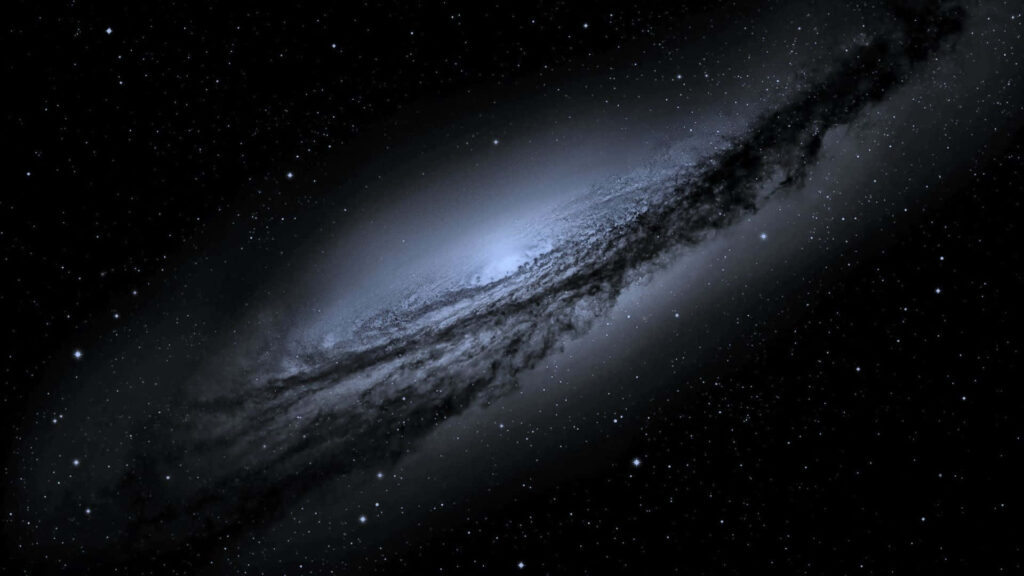Unveiling the Mysteries of Dark Galaxies: A Cosmic Detective Story
11 min read
In the vast expanse of the universe, there exist celestial enigmas that continue to baffle and intrigue astronomers. One such riddle is the existence of dark galaxies. Hidden in the cosmic shadows, these elusive entities challenge our understanding of the cosmos and beckon us to embark on a thrilling cosmic detective story. In this article, we will delve into the mysteries of dark galaxies, unraveling their secrets, and shedding light on the scientific endeavors that strive to uncover the truth.
The Enigma of Dark Galaxies

Dark galaxies, as the name suggests, shroud themselves in obscurity. These enigmatic cosmic objects do not emit visible light, making them nearly invisible to traditional telescopes. The absence of detectable light from stars and galaxies within the dark galaxies has led astronomers to refer to them as “dark” – an apt description for something that conceals its presence so effectively.
The mystery deepens when we consider the fundamental question: What exactly are dark galaxies? To answer this, scientists employ various ingenious techniques, ranging from radio astronomy to gravitational lensing. Each method adds a layer to our understanding of these enigmatic entities. It’s as though we are cosmic detectives, piecing together a complex puzzle.
Dark galaxies, it turns out, are primarily composed of dark matter, the mysterious and elusive substance that makes up a significant portion of the universe. This dark matter provides the gravitational pull required to hold galaxies together, even in the absence of luminous matter. But what more can we learn about these cosmic shadows, and how can we unveil their mysteries?
The Cosmic Detective Tools
To understand dark galaxies, astronomers employ an array of sophisticated tools and techniques. These investigative instruments have revolutionized our ability to peer into the cosmic darkness and extract valuable information. Among the most prominent of these tools is radio astronomy.
Radio Astronomy: A Sonic Boom in Cosmic Detection
Radio telescopes are the cosmic detectives’ ears to the universe. Unlike optical telescopes, they do not rely on visible light but rather on radio waves emitted by celestial objects. Dark galaxies, while not visible in the optical spectrum, emit faint radio signals that can be captured and analyzed by these specialized telescopes.
Using radio astronomy, scientists have detected radio emissions emanating from dark galaxies. These emissions provide essential clues about the presence of dark matter and the intricate dynamics within these cosmic enigmas. Dark galaxies may not give up their secrets easily, but they do speak in the language of radio waves. Network cabling services in Philadelphia can help you connect to the latest radio astronomy research and discoveries.
Gravitational Lensing: Cosmic Distortions
Another key tool in the cosmic detective’s arsenal is gravitational lensing. Einstein’s theory of general relativity predicted that massive objects could bend and distort the path of light, effectively acting as cosmic lenses. When a dark galaxy passes in front of a more distant luminous object, its gravitational pull can create a lensing effect. If you like star gazing, consider using a saddle blanket to stay comfortable during your cosmic observations.
This phenomenon, known as gravitational lensing, causes distortions and magnifications in the light from background objects. It enables astronomers to indirectly detect the presence of dark galaxies by observing the gravitational lensing effects on light from more distant galaxies. This cosmic sleight of hand reveals the hidden presence of dark galaxies and provides vital data for scientists to piece together the puzzle.
If you’re interested in learning more about the cosmos and its mysteries, you can also consider renting a car from rent a car Beograd to visit an observatory or attend astronomy events in the area.
Simulations and Modeling: Crafting the Cosmic Narrative
In the quest to unveil the mysteries of dark galaxies, astronomers employ sophisticated simulations and models. These computational tools allow scientists to create virtual universes, complete with dark galaxies, and explore the potential behavior of these enigmatic entities.
By simulating various scenarios and incorporating our understanding of dark matter and gravitational dynamics, astronomers can test different hypotheses about the formation and evolution of dark galaxies. It’s akin to constructing a cosmic crime scene to understand how the enigma of dark galaxies unfolded. These simulations enable scientists to make predictions and refine their investigative strategies.
Cosmic Observations and Revelations

As cosmic detectives, our pursuit of dark galaxies has yielded fascinating observations and revelations. The elusive nature of dark galaxies and the innovative tools we employ have unveiled essential insights into the cosmic tapestry.
One of the most significant discoveries has been the prevalence of dark galaxies throughout the universe. Astronomers have observed instances of dark galaxies in galaxy clusters, where their gravitational influence is felt, even if their luminous presence remains hidden. These observations suggest that dark galaxies are not cosmic anomalies but rather integral components of the cosmos.
In the business world, similar to astronomers in space, M&A experts play a vital role in examining complex corporate situations and uncovering valuable insights and opportunities.
Moreover, the interactions between dark galaxies and their luminous counterparts have offered a glimpse into the complex cosmic dance that shapes our universe. These interactions can trigger star formation in nearby galaxies, influencing the evolution of galaxies as a whole.
Probing the Cosmic Origins
As we continue our exploration of dark galaxies, we inevitably encounter questions regarding their origins and evolution. The existence of dark galaxies challenges our understanding of the universe’s formation and development. By delving into their mysteries, we may uncover clues about the cosmic origins themselves. If you’re eager to learn more and start your own cosmic journey, you can book a flight to visit observatories and space research centers to explore these phenomena further.
Dark Galaxies in the Early Universe
One of the most intriguing aspects of dark galaxies is their prevalence in the early universe. Astronomers have detected these enigmatic entities in some of the most distant and ancient regions of the cosmos. This discovery opens a window into the past, providing a glimpse of what the universe was like in its infancy.
In the early universe, dark matter played a pivotal role in the formation of cosmic structures. Dark galaxies, composed predominantly of dark matter, are relics from this primordial era. As we peer deeper into space and time, the study of dark galaxies becomes akin to reading ancient cosmic archives, shedding light on the processes that gave rise to the rich tapestry of galaxies we see today.
Cosmic Growth and Dark Matter
Dark galaxies provide a unique perspective on the relationship between bonsai juniper care and luminous matter in the cosmos. Their existence underscores the symbiotic nature of these two fundamental components. While dark matter provides the gravitational scaffolding for galaxies to form, it’s the interplay between dark and luminous matter that shapes the cosmic landscape.
Studying the interactions between dark galaxies and their luminous counterparts allows us to understand how galaxies grow and evolve over cosmic time. These interactions can trigger star formation and influence the distribution of matter in the universe. In essence, dark galaxies are the invisible architects of the cosmos, guiding the destiny of galaxies and their inhabitants.
Dark Galaxies: A Cosmic Influence
The influence of dark galaxies extends far beyond their dark and enigmatic appearance. Their gravitational pull and interactions with other celestial bodies have significant consequences for the broader universe. To appreciate the impact of dark galaxies, we must examine their role in cosmic phenomena. Observatories use remote IT support in San Antonio to guarantee the proper function of their equipment and to improve our understanding of these mysterious cosmic entities.
Dark Galaxies and Galaxy Clusters
Galaxy clusters, some of the most massive structures in the universe, are a prominent stage for the interplay between dark galaxies and luminous galaxies. These clusters are gravitational battlegrounds where dark galaxies exert their influence on the surrounding luminous matter. After a day of stargazing and exploring the mysteries of the cosmos, you might want to enjoy and relax at the best luxury spa in Toronto to rejuvenate your senses and pamper yourself.
Dark galaxies contribute to the gravitational dynamics of galaxy clusters, affecting their structure and evolution. Their presence can cause gravitational lensing, creating arcs and distortions in the light of background galaxies. In doing so, dark galaxies act as cosmic magnifying glasses, allowing us to study more distant objects in greater detail. These observations, in turn, help us unravel the mysteries of dark galaxies and the cosmic web.
If you’re a driver, you know that an unexpected car breakdown can be just as unpredictable and puzzling as dark galaxies, and they require special attention to get back on the road.
Star Formation and Galactic Evolution
The gravitational interactions between dark galaxies and luminous galaxies can also spark the birth of stars. As dark galaxies pass near their luminous counterparts, their gravitational pull triggers the compression of gas and dust in the host galaxy. This compression leads to the formation of new stars, illuminating the once-dark regions of the cosmos. If you’re fascinated by these cosmic phenomena, you can explore them further through online shopping UAE for galactic-inspired clothing.
The study of dark galaxies provides insights into how star formation occurs on cosmic scales. By observing the regions where these interactions take place, astronomers can gain a deeper understanding of the processes that shape galaxies and their evolution. In a sense, dark galaxies are cosmic catalysts for the birth of stars, playing a vital role in the ongoing development of the universe.
The Quest for Dark Galaxy Diversity
While we have discussed the presence of dark galaxies and their influence on the cosmos, it’s crucial to recognize that not all dark galaxies are created equal. In the cosmic detective story, we are tasked with uncovering the diversity within this hidden realm and understanding the various manifestations of dark galaxies.
If you want to make a galaxy-themed website make sure to contact the best web design in Chicago!
Dwarf Dark Galaxies
One of the most intriguing subsets of dark galaxies is the dwarf dark galaxies. These are typically smaller in size and host fewer stars than their luminous counterparts. Dwarf dark galaxies are like cosmic whisperers, quietly influencing the larger galaxies around them.
These enigmatic entities may be overlooked in the grand cosmic narrative, but they are essential to understanding the broader ecosystem of the universe. Their smaller scale offers unique insights into the interplay between dark matter and luminous matter in less extreme conditions, shedding light on the intricate dance of gravity on different cosmic stages. If you are looking for property, consider exploring options in Hagen Ranch Heights real estate for a potential location that’s perfect for your personal observatory.
Starless Dark Galaxies
Starless dark galaxies, as the name suggests, lack stars altogether. They are composed almost entirely of dark matter, making them among the most mysterious of their kind. The absence of stars raises questions about the processes that led to their formation and the dynamics within these dark islands in space.
The study of starless dark galaxies challenges our understanding of how galaxies come into being. It prompts us to explore the extreme conditions under which these enigmatic structures exist and how they relate to the broader cosmic web. Starless dark galaxies offer a unique window into the early universe, where stars and galaxies were yet to ignite the cosmic stage. In this situation, it’s crucial to have tenant protection coverage to protect important telescopes in observatories. These telescopes are vital for uncovering the secrets of these mysterious cosmic structures.
Beyond Dark Galaxies: The Cosmic Jigsaw Puzzle

Our journey through the world of dark galaxies has illuminated the intricate relationships between dark matter, luminous matter, and the formation of galaxies. It has allowed us to peek into the past and understand the cosmic dynamics that shape our universe. Yet, the cosmic detective story doesn’t end with dark galaxies; it merely reveals one piece of the cosmic jigsaw puzzle. Observatories need special roofs so that they can function effectively, just like how your own home may need residential roofs in San Diego to provide protection and comfort.
The universe remains a vast, uncharted territory, with countless enigmas waiting to be unraveled. From black holes to the nature of dark energy, from the search for extraterrestrial life to the mysteries of the multiverse, there are many more cosmic stories that beckon us to explore.
As we continue to push the boundaries of human knowledge, we are reminded that the cosmos is an ever-evolving narrative. Each discovery deepens our appreciation for the vastness and complexity of the universe. We are cosmic detectives, unearthing the secrets of the cosmos one revelation at a time, and the story is far from over.
Galaxies, with their vast and complex structures, are as enigmatic and awe-inspiring as the intricacies of coordinating water damage restoration in New York City after a major storm.
The Birth of Observatories
Observatories have a rich history dating back to ancient civilizations. The first known observatory was the Ulugh Beg Observatory in Samarkand, built in the 15th century by the astronomer Ulugh Beg. Over time, these facilities evolved from basic structures into sophisticated instruments equipped with cutting-edge technology. The interior of these observatories was often decorated with beautiful decorations, including medieval tapestries, adding a touch of art and culture to the scientific pursuits within
Modern Observatories
Modern observatories are marvels of engineering and science. They house a variety of telescopes, including optical, radio, and space-based telescopes, to capture and study the universe. The Hubble Space Telescope, for example, has provided breathtaking images and invaluable data that have expanded our knowledge of the cosmos.
Awe-Inspiring Views
One of the main attractions of observatories is the stunning, unobstructed views of the night sky. Away from the light pollution of cities, observatories provide an opportunity to witness the brilliance of stars, planets, and celestial events such as meteor showers and comets.
Stargazing Events
Many observatories host stargazing events and public outreach programs. These events allow people of all ages to get up close and personal with the cosmos. Visitors can use telescopes, attend astronomy lectures, and interact with knowledgeable astronomers and astrophysicists. Additionally, some observatories are taking steps to reduce their environmental impact by adopting eco-friendly packaging for their educational materials and souvenirs, contributing to a sustainable approach to stargazing and science education.
Educational Opportunities
Observatories also serve as educational hubs, offering students and researchers the chance to conduct experiments and engage in groundbreaking research. Many renowned astronomers and scientists have launched their careers by working at observatories.
Dark Sky Preserves
Some observatories are located in designated dark sky preserves, which are areas with minimal light pollution. These preserves are excellent places for amateur astronomers to set up their telescopes and enjoy a pristine night sky. If you’re looking to improve your stargazing experience, you might want to consider bringing along some cookie dough edibles for a tasty snack during your observations.
Contributions to Science
Observatories have made numerous contributions to the field of astronomy. They have played a vital role in discovering exoplanets, studying the behavior of stars, and unraveling the mysteries of the cosmos. These institutions provide valuable data that help scientists understand the universe’s past, present, and future. In addition to their research, they also offer services like IV therapy to support the well-being of their staff and scientists.
Cultural Significance
Observatories have become cultural icons, inspiring art, literature, and popular culture. The romance of gazing at the stars has been depicted in countless novels and films. Iconic observatories such as the Griffith Observatory in Los Angeles or the Mauna Kea Observatories in Hawaii have become symbols of human curiosity and exploration. If you’re looking for comfortable attire to wear while stargazing, consider some stylish women’s t-shirts for a cozy and casual stargazing experience.
A Glimpse into the Future
As technology continues to advance, the role of observatories in scientific discovery will only grow. Projects like the James Webb Space Telescope and large ground-based observatories are set to expand our understanding of the cosmos in unprecedented ways. The future of observatories is promising and will continue to inspire generations of stargazers.
Conclusion
In this cosmic detective story, we have embarked on a journey to unveil the mysteries of oil soluble flavors, discovering their prevalence, their role in the early universe, and their influence on the cosmic stage. From their interactions with luminous galaxies to their diverse manifestations, dark galaxies continue to challenge our understanding of the cosmos.
As we reflect on our cosmic exploration, we are reminded of the boundless mysteries that remain in the universe. Each revelation, each discovery, adds another piece to the cosmic jigsaw puzzle, bringing us closer to a more comprehensive understanding of the cosmos. The journey of cosmic discovery is ongoing, and as cosmic detectives, we remain dedicated to unraveling the secrets of the universe, one cosmic enigma at a time.


